For a water-damaged camera lens, we recommend immediate action by powering off the device, gently wiping exterior surfaces with a microfiber cloth, and avoiding vigorous shaking. Place the lens in a sealed bag with silica gel packets or uncooked rice for 8-24 hours to absorb moisture. DIY methods show approximately 60% success for minor exposure, while severe cases may require professional repair services costing $50-$200. Our detailed techniques address both condensation fogging and more serious water infiltration issues.
Key Takeaways
- Power off your camera immediately and remove the battery and memory cards to prevent electrical damage.
- Gently wipe external lens surfaces with a microfiber cloth without applying pressure or shaking vigorously.
- Place your camera and lens in a sealed bag with silica gel packets or uncooked rice for 8-24 hours.
- Avoid using heat sources like hairdryers that can damage lens elements and coatings.
- For saltwater damage or persistent internal fogging, seek professional repair within 48 hours.
Understanding the Different Types of Water Damage in Camera Lenses
The intricate design of modern camera lenses makes them particularly vulnerable to water damage, which can manifest in various forms depending on the type of exposure. We need to distinguish between freshwater and saltwater damage, as the latter contains highly conductive minerals that accelerate corrosion in electronic components and mechanical parts.
Mineral Damage occurs when dissolved salts and minerals in water create conductive pathways across circuit boards, leading to shorts and permanent failure in autofocus motors or aperture controls. Even after drying, these mineral deposits remain as residue that continues to degrade performance. Condensation Effects, on the other hand, typically result from rapid temperature changes, causing moisture to form inside the lens elements. This internal fogging impairs optical clarity and, if left untreated, can lead to fungal growth between elements that permanently degrades image quality. Proper drying techniques and protective measures are essential to prevent water infiltration from causing long-term damage to the lens components.
Immediate Actions to Take When Your Lens Gets Wet
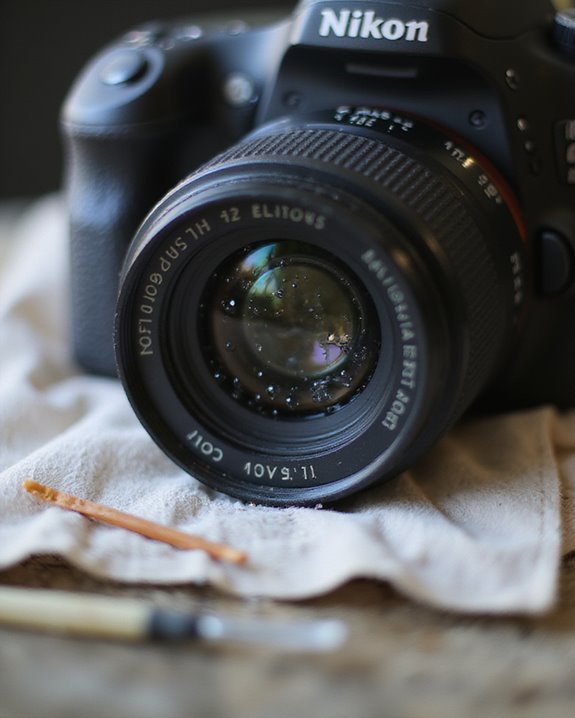
When a camera lens becomes unexpectedly wet, reacting swiftly and methodically can mean the difference between salvaging your equipment and facing costly repairs or replacement. We recommend carrying an Emergency Kit containing microfiber cloths and silica gel packets for such situations. Immediately power down the device, remove the battery and memory cards, and keep compartments open to facilitate airflow. Gently wipe external surfaces with a lint-free cloth, avoiding vigorous shaking that could force moisture deeper into optical elements. Using specialized lens cleaning tools can help carefully remove moisture from delicate surfaces without causing damage. For effective On Site Care, position the equipment in a dry, moderate-temperature environment away from direct sunlight. Don’t use rice, compressed air, or heat sources, as these can introduce contaminants or damage delicate components. Instead, allow 24-48 hours of undisturbed drying time before cautiously testing functionality.
Effective Drying Methods for Moisture Removal
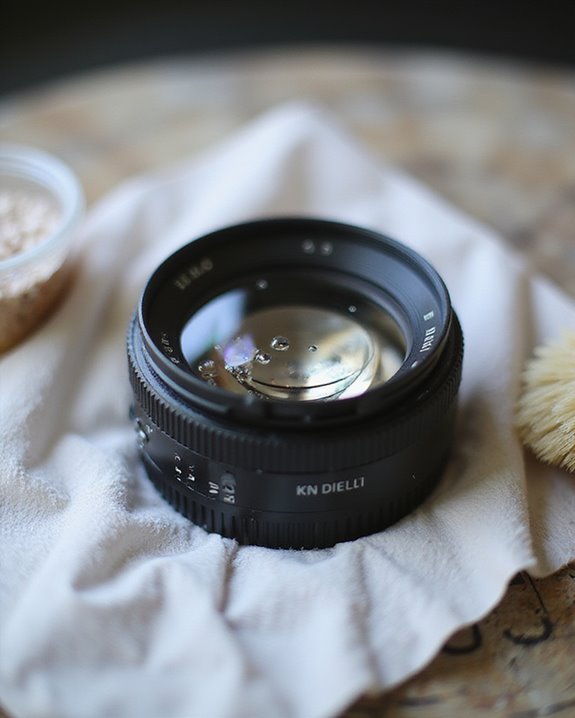
Removing moisture from your camera lens requires several proven drying methods that’ll prevent long-term damage to your optical equipment. We recommend placing affected equipment in a sealed bag with silica gel desiccants, which efficiently absorb internal moisture through capillary action. Gentle warming, such as exposure to moderate sunlight or placement near a radiator (never exceeding 95°F), can accelerate evaporation without risking thermal damage to delicate lens components. Additionally, using professional cleaning kits that include sensor swabs and cleaning solutions can help maintain the overall integrity of your camera’s internal parts. For ideal results, guarantee proper air circulation around the lens, and consider utilizing absorbent materials like rechargeable desiccant packs for repeated treatments. Dehumidification cabinets represent a professional-grade solution, offering precise humidity control for valuable photography equipment. When utilizing thermal methods, maintain consistent, low heat to prevent component warping or adhesive degradation that could permanently compromise optical performance.
Using Household Items to Extract Water From Camera Lenses
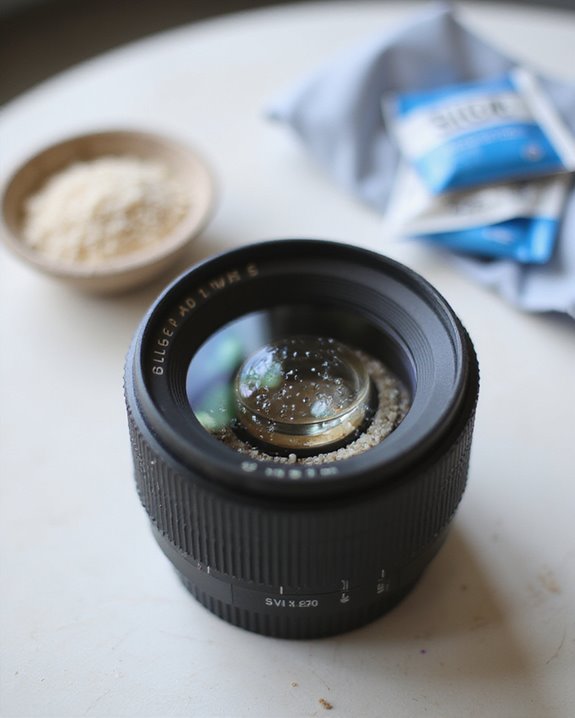
Many common household items can serve as effective solutions for extracting moisture from camera lenses, often eliminating the need for specialized equipment during water-related emergencies. Based on user reviews, uncooked rice in an airtight container provides reliable moisture absorption, requiring 8-24 hours for effectiveness with minimal environmental impact compared to single-use desiccants. Silica gel packets, salvaged from product packaging, offer superior absorption properties without introducing dust particles that could compromise lens elements.
For immediate intervention, a hair dryer on its lowest setting, held at least 12 inches from the lens, can accelerate evaporation without thermal damage to sensitive components. Microfiber cloths, particularly those with a GSM (grams per square meter) rating of 300+, provide ideal absorption capabilities for surface moisture while minimizing the risk of micro-abrasions to lens coatings.
Professional Techniques and Specialized Tools for Water Extraction
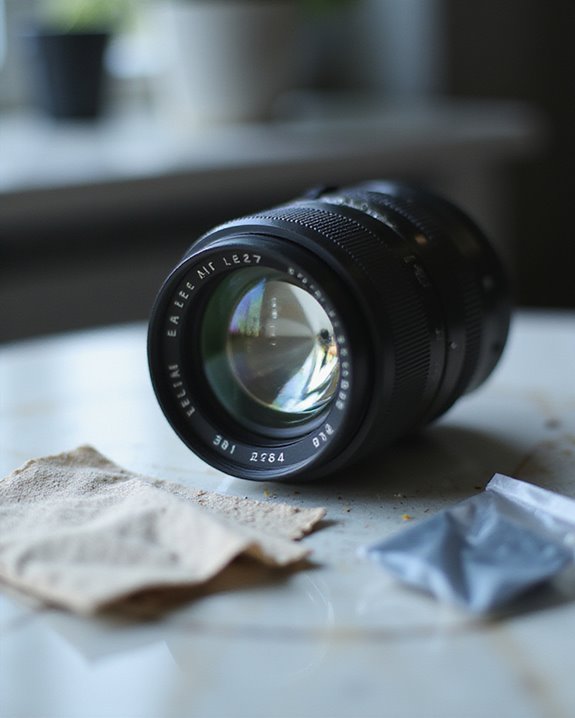
Professional technicians employ sophisticated equipment and methodologies that surpass household remedies for extracting water from camera lenses, offering precision and thoroughness that can’t be matched by DIY approaches. Industrial vacuum desiccators create negative pressure environments that accelerate moisture evaporation, while calibrated ultrasonic systems can dislodge water from internal components when operated at appropriate frequencies. Complete Lens Disassembly using JIS screwdrivers enables technicians to target moisture with anti-static brushes and 99% isopropyl alcohol, followed by microscope-assisted inspection for mineral deposits. For water-damaged sensors, specialized vacuum paddles and electrostatic wands extract moisture without direct contact. Coating Repair kits address delamination issues, while conformal coatings protect circuit boards post-drying. Professionals also employ silica gel canisters with humidity indicators to verify complete dryness before reassembly and reapplication of lens-safe lubricants.
Preventing Future Water Damage to Your Camera Equipment
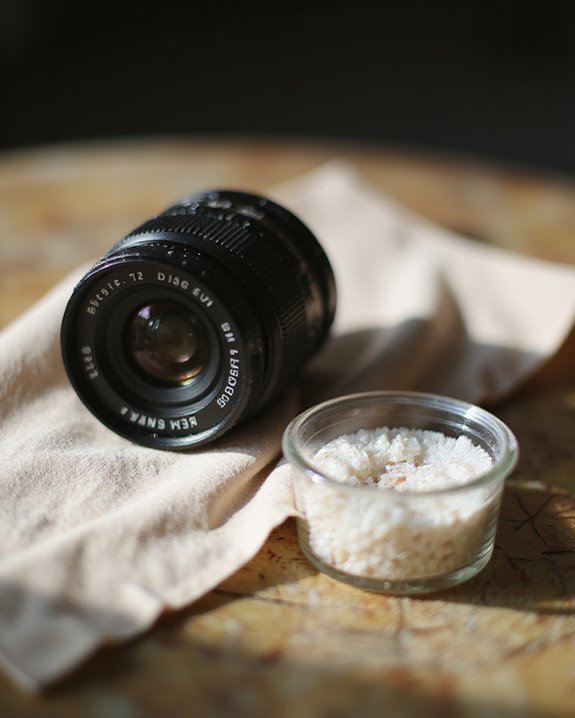
While professional repairs may restore a water-damaged lens, prevention remains the most effective strategy for protecting your valuable camera equipment. We recommend investing in waterproof cases and weather-sealed camera models that incorporate advanced materials specifically designed to resist moisture penetration. Always keep your camera’s firmware updates current, as manufacturers occasionally improve weather resistance functionality through software enhancements. Store your equipment in dry, well-ventilated areas with silica gel packets to absorb ambient moisture, and implement proper operational protocols when shooting in damp conditions. Modern cameras from brands like Olympus offer exceptional durability in wet environments, but even these require proper handling. When not in use, apply lens caps and body covers to prevent debris accumulation that could eventually attract moisture. Remember to establish rapid response plans for accidental exposure, including immediate power-off procedures and component removal.
When to Seek Professional Repair Services
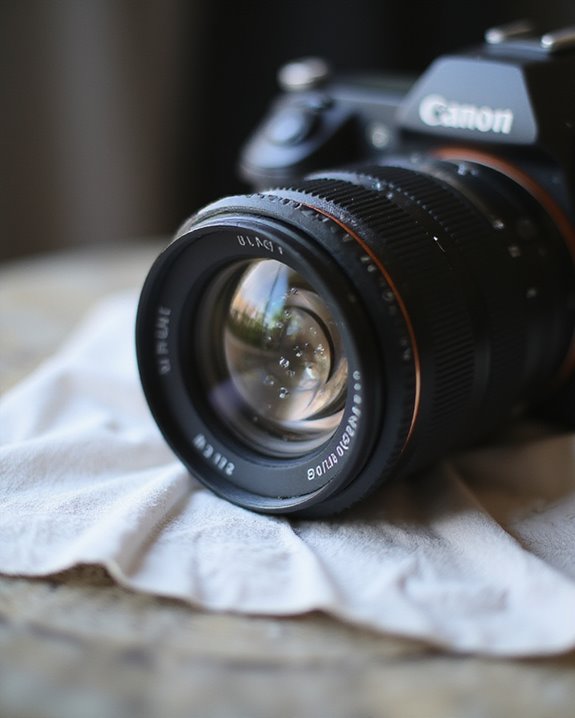
Despite your best efforts with DIY drying methods, certain water damage scenarios demand professional intervention to salvage your camera equipment. When dealing with salt water exposure, visible corrosion, or moisture trapped beneath lens elements, immediate expert assessment becomes vital. Many manufacturers, such as Canon and Nikon, offer specialized repair services with warranties for water-damaged equipment.
Budget considerations should factor prominently in your decision-making process. Professional repairs typically range from $200-$500 depending on damage severity, but this investment may be justified for high-end DSLR bodies or professional-grade lenses. Expert recommendations suggest seeking professional help within 48 hours of water exposure to minimize circuit board damage and prevent fungal growth. Third-party repair shops often provide more economical solutions than manufacturer services, with comparable quality assurances and shorter turnaround times for common water damage issues.
Frequently Asked Questions
Will Water Damage Affect My Camera’s Warranty?
Yes, we’re sorry to say most warranties won’t cover water damage. Warranty claims typically get denied as voidance rules specifically exclude liquid damage unless your camera is waterproof by design. Check your policy for details.
How Long Does a Camera Lens Typically Take to Dry Completely?
We’ve found lens drying typically takes 24-72 hours depending on humidity factors. Using proper drying methods can speed this up – silica gel works faster (24-48 hours) than rice (full 72 hours sometimes needed).
Can Lens Fungus Develop From Water Exposure?
Yes, water exposure can directly trigger lens fungus. We’ll see symptoms like cloudy spots and haziness. Prevention methods include immediate drying, storing with silica gel, and maintaining low humidity environments for our equipment.
Are Waterproof Camera Cases Worth the Investment?
In summary, we think waterproof cases are worth it. Case benefits include equipment protection and underwater photography capabilities. Investment drawbacks? They’re bulky and model-specific. We’d recommend them if you’re shooting near water regularly.
Does Insurance Typically Cover Water Damage to Camera Equipment?
Insurance policies typically don’t cover water damage to camera equipment unless you’ve purchased specialized coverage. We recommend checking your policy details carefully and understanding the claim process before an accident happens.





